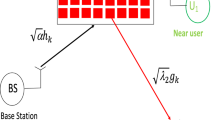Abstract
In this paper, we propose to improve the physical layer security of non orthogonal multiple access (NOMA) using reconfigurable intelligent surfaces (RIS). RIS is decomposed in different sets of reflectors dedicated to NOMA users. As reflections reach the ith user with the same phase, the transmitter can reduce its power so that the eavesdropper cannot detect its signal. We derive the secrecy outage probability and the Strictly positive secrecy capacity (SPSC) for NOMA systems using RIS for Rayleigh fading channels.









Similar content being viewed by others
Availability of Data Material
Data and material are not available.
References
Basar, E., Di Renzo, M., De Rosny, J., Debbah, M., , Alouini, M. -S. & Zhang, R. (2019). Wireless communications through reconfigurable intelligent surfaces. IEEE Access, 7, 116753–116773.
Zhang, H., Di, B., Song, L., & Han, Z. (2020). Reconfigurable intelligent surfaces assisted communications with limited phase shifts: How many phase shifts are enough? IEEE Transactions on Vehicular Technology, 69(4), 4498–4502.
Di Renzo, M. (2019). 6G Wireless: Wireless networks empowered by reconfigurable intelligent surfaces. In 2019 25th Asia-Pacific Conference on Communications (APCC).
Basar, E. (2020). Reconfigurable intelligent surface-based index modulation: A new beyond MIMO paradigm for 6G.IEEE Transactions on Communications, 68(5), 3187–3196.
Qingqing, W., & Zhang, R. (2020). Towards smart and reconfigurable environment: Intelligent reflecting surface aided wireless network. IEEE Communications Magazine, 58(1), 106–112.
Huang, C., Zappone, A., Alexandropoulos, G. C., Debbah, M., & Yuen, C. (2019). Reconfigurable intelligent surfaces for energy efficiency in wireless communication. IEEE Transactions on Wireless Communications, 18(8), 4157–4170.
Alexandropoulos, G. C., & Vlachos, E. (2020). A hardware architecture for reconfigurable intelligent surfaces with minimal active elements for explicit channel estimation. In ICASSP 2020—2020 IEEE international conference on acoustics, speech and signal processing (ICASSP).
Fang, D., Qian, Y., & Hu, R. Q. (2018). Security for 5G mobile wireless networks. IEEE Access, 6, 4850–4874.
Bloch, M., & Barros, J. (2011). Physical-Layer Security: From Information Theory to Security Engineering. Cambridge: Cambridge University Press.
Zhang, Y., Wang, H.-M., Yang, Q., et al. (2016). Secrecy sum rate maximization in non-orthogonal multiple access. IEEE Communications Letters, 20(5), 930–933.
Qin, Z., Liu, Y., & Ding, Z., et al. (2016). Physical layer security for 5G non-orthogonal multiple access in large-scale networks. In Communications (ICC), 2016 IEEE International Conference on (pp. 1-6). IEEE.
Liu, Y., Qin, Z., Elkashlan, M., et al. (2017). Enhancing the physical layer security of non-orthogonal multiple access in large-scale networks. IEEE Transactions on Wireless Communications, 16(3), 1656–1672.
Thapar, S., Mishra, D., & Saini, R. (2020). Novel outage-aware NOMA protocol for secrecy fairness maximization among untrusted users. IEEE Transactions on Vehicular Technology, 69(11), 13259–13272.
Webb, H., Yin, C., Ngoc Nguyen, D., Le, T. T. N., Do, H. V., Van Hoang, D., & Van Nguyen, N. (2020). Secrecy outage analysis in energy harvesting relay networks with a friendly jammer. In 2020 4th international conference on recent advances in signal processing, telecommunications and computing (SigTelCom).
Dang-Ngoc, H.,Ho-Quoc, B., & Ho-Van, K. (2020). Key secrecy performance metrics of overlay networks with energy scavenging and artificial noise. In 2020 4th international conference on recent advances in signal processing, telecommunications and computing (SigTelCom).
Trinh, P. V., Carrasco-Casado, A. , Pham, A. T., & Toyoshima, M. (2020). Secrecy analysis of FSO systems considering misalignments and eavesdropper’s location. IEEE Transactions on Communications.
Byungha, Y., In-Ho, L., & Haejoon, J. (2020). Exact secrecy rate analysis of antenna subset modulation schemes. IEEE Systems Journal, Year, 68(12), 7810–7823.
Kumar, S, Garg, A., & Bhatnagar, M. R. (2020). Physical layer secrecy performance analysis of imperfect feedback based 41 MISO system. In 2020 international conference on signal processing and communications (SPCOM).
He, B., Lv, L., Yang, L., & Chen, J. (2020). Enhancing secrecy for NOMA untrusted relay networks with user scheduling and jamming. IEEE Communications Letters, 24(12), 2682–2686.
Khojastehnia, M., & Loyka, S. (2020). Comments on ‘Precoding for secrecy rate maximisation in cognitive MIMO wiretap channels’. Electronics Letters, 56(17), 902–904.
Proakis, J. (2007). Digital Communications (5th ed.). New-York: Mac Graw-Hill.
Acknowledgements
This publication was supported by the Deanship of Scientific Research at Prince Sattam bin Abdulaziz University, Alkharj, Saudi Arabia.
Funding
This publication received no funding.
Author information
Authors and Affiliations
Contributions
The paper is the contribution of Prof. Faisal Alanazi.
Corresponding author
Ethics declarations
Conflict of interest
The authors state that there is no conflict of interest for this paper.
Additional information
Publisher's Note
Springer Nature remains neutral with regard to jurisdictional claims in published maps and institutional affiliations.
Rights and permissions
About this article
Cite this article
Alanazi, F. Physical Layer Security of Non Orthogonal Multiple Access Using Reconfigurable Intelligent Surfaces. Wireless Pers Commun 122, 2145–2160 (2022). https://doi.org/10.1007/s11277-021-08985-0
Accepted:
Published:
Issue Date:
DOI: https://doi.org/10.1007/s11277-021-08985-0




